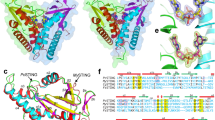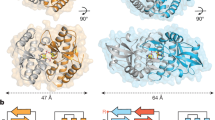Abstract
STING (stimulator of interferon genes) is an essential signaling adaptor that mediates cytokine production in response to microbial invasion by directly sensing bacterial secondary messengers such as the cyclic dinucleotide bis-(3′-5′)-cyclic dimeric GMP (c-di-GMP). STING's structure and its binding mechanism to cyclic dinucleotides were unknown. We report here the crystal structures of the STING cytoplasmic domain and its complex with c-di-GMP, thus providing the structural basis for understanding STING function.


Similar content being viewed by others
References
Takeuchi, O. & Akira, S. Immunol. Rev. 227, 75–86 (2009).
Barbalat, R., Ewald, S.E., Mouchess, M.L. & Barton, G.M. Annu. Rev. Immunol. 29, 185–214 (2011).
Ishikawa, H. & Barber, G.N. Nature 455, 674–678 (2008).
Ishikawa, H., Ma, Z. & Barber, G.N. Nature 461, 788–792 (2009).
Sun, W. et al. Proc. Natl. Acad. Sci. USA 106, 8653–8658 (2009).
Zhong, B. et al. Immunity 29, 538–550 (2008).
Jin, L. et al. Mol. Cell Biol. 28, 5014–5026 (2008).
Tamayo, R., Pratt, J.T. & Camilli, A. Annu. Rev. Microbiol. 61, 131–148 (2007).
Jin, L. et al. J. Immunol. 187, 2595–2601 (2011).
Burdette, D.L. et al. Nature 478, 515–518 (2011).
Holm, L. & Rosenstrom, P. Nucleic Acids Res. 38, W545–W549 (2010).
Deng, J. et al. Proc. Natl. Acad. Sci. USA 105, 1499–1504 (2008).
Krissinel, E. & Henrick, K. J. Mol. Biol. 372, 774–797 (2007).
Chen, W., Kuolee, R. & Yan, H. Vaccine 28, 3080–3085 (2010).
Ouyang, S. et al. Immunity published online, doi:10.1016/j.immuni.2012.03.019 (10 May 2012).
Guerrero, S.A., Hecht, H.J., Hofmann, B., Biebl, H. & Singh, M. Appl. Microbiol. Biotechnol. 56, 718–723 (2001).
Kabsch, W. Acta Crystallogr. D Biol. Crystallogr. 66, 125–132 (2010).
Adams, P.D. et al. Acta Crystallogr. D Biol. Crystallogr. 66, 213–221 (2010).
Emsley, P. & Cowtan, K. Acta Crystallogr. D Biol. Crystallogr. 60, 2126–2132 (2004).
Jeanmougin, F., Thompson, J.D., Gouy, M., Higgins, D.G. & Gibson, T.J. Trends Biochem. Sci. 23, 403–405 (1998).
Gouet, P., Courcelle, E., Stuart, D.I. & Metoz, F. Bioinformatics 15, 305–308 (1999).
Acknowledgements
We thank the Shanghai Synchrotron Radiation Facilities (SSRF), China, and the Photon Factory (PF) at High Energy Accelerator Research Organization (KEK), Japan for help with data collection, and M. Tian and L. Finci for language editing. This work was supported by funds from the National Basic Research Program of China 973 (No. 2011CB911103 to X.-D.S.) and National High Technology, 863 Program (2006AA02A317 to X.-D.S.). Peking University's 985 and 211 grants are highly appreciated.
Author information
Authors and Affiliations
Contributions
Y.-H.H., assisted by X.-X.D., accomplished protein expression, purification and other biochemistry experiments as well as crystallization, performed some data analysis and prepared the manuscript. Data collection and processing were performed by Y.-H.H., X.-Y.L. and X.-D.S. Phase determination, model building and structure refinement were accomplished by X.-Y.L., Y.-H.H. and X.-D.S. Y.-H.H., X.-Y.L. and X.-D.S. analyzed the structures and wrote the paper. Z.-F.J. and X.-D.S. initiated, designed and supervised the project.
Corresponding author
Ethics declarations
Competing interests
The authors declare no competing financial interests.
Supplementary information
Supplementary Text and Figures
Supplementary Figures 1–5 and Supplementary Table 1 (PDF 748 kb)
Rights and permissions
About this article
Cite this article
Huang, YH., Liu, XY., Du, XX. et al. The structural basis for the sensing and binding of cyclic di-GMP by STING. Nat Struct Mol Biol 19, 728–730 (2012). https://doi.org/10.1038/nsmb.2333
Received:
Accepted:
Published:
Issue Date:
DOI: https://doi.org/10.1038/nsmb.2333
- Springer Nature America, Inc.
This article is cited by
-
Second messenger 2'3'-cyclic GMP-AMP (2'3'-cGAMP): the cell autonomous and non-autonomous roles in cancer progression
Acta Pharmacologica Sinica (2024)
-
β-adrenoreceptor-triggered PKA activation negatively regulates the innate antiviral response
Cellular & Molecular Immunology (2023)
-
cGAMP-activated cGAS–STING signaling: its bacterial origins and evolutionary adaptation by metazoans
Nature Structural & Molecular Biology (2023)
-
Molecular mechanisms of mitochondrial DNA release and activation of the cGAS-STING pathway
Experimental & Molecular Medicine (2023)
-
Crystal structure and functional implication of bacterial STING
Nature Communications (2022)





